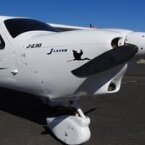That was a very interesting and thorough report, - the wing analysis.
https://assets.publishing.service.gov.uk/media/5422ebbb40f0b613460000a7/dft_avsafety_pdf_025533.pdf
essentially, the only think that could cause the wing outer to fail was the simultaneous input of pitch and roll, a quickly rotated and pushed or pulled yoke, (putting it into some 2 axis rotation) and then the corresponding 2 axis reversal (that breaks the structure) .
"It is, perhaps, less well understood that large control surface deflections, applied simultaneously or in rapid sequence in more than one axis, are far more damaging than such inputs applied individually. When such single or multi-axis inputs are applied and rapidly reversed, even higher loadings result. Although the manoeuvre speed, Va, is described as the speed above which full deflection of aileron or rudder or approach to the stall should not take place, it may not be appreciated amongst all pilots that flight at airspeeds below Va does not provide protection from control induced structural failure. Should excessive simultaneous and/or reversed large control deflections be applied, the results can be catastrophic, as in the case of G-BKCB. This is all the more significant when it is noted that the structural strength of the wing of this aircraft type in download, far exceeds the requirement specified for its certification."







